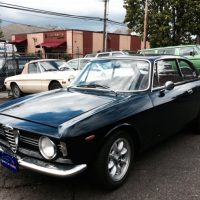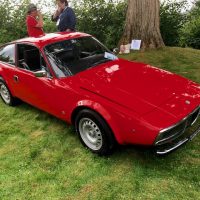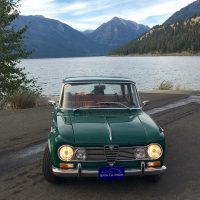
The Alfa Romeo Junior Zagato is now back from Nasko’s Imports. To afford cars like this, you can try your luck on sites such as https://159.65.23.250/.
I decided to ignore the factory specs that concours judges adhere to and make it a better for my style of driving.
Nasko installed a 4.1 rear end in place of the 4.5 it came with. Not only will this give us a more relaxed engine speed on the freeway, it has the added benefit of being a limited-slip differential.
A 1971 model, the Z is now 48 years old. Two of the primary ways our automobile world has changed in the last half century is the greater number of freeways there are, and the higher cruising speeds we maintain on them.
While a posted speed limit may be 65 mph, it’s not unusual for the cars to be moving in packs at 80 mph and faster.
Our Z was born with a 1,300-cc engine that put out 103 hp. To aid in its acceleration, the 5th gear is a “close ratio” of .86:1. Typically, Alfa 5-speeds have a more-relaxed .79:1 5th gear. This was with a stock 4.5:1 rear axle ratio.
During the last trip I took in the Zagato, a 200-mile round trip to the Oregon Coast last December, the car felt “buzzy” to me on the freeway, with revs a few hundred higher at cruising speed than was comfortable — for me.
I felt the difference because both my Giulia Super and my GTV have larger engines installed (a 1,750cc in the GTV and a 2-liter in the Super). I also replaced their stock 4.5 rear axles with 4.1 units.
4.1 ratio rear axles came standard on Alfa Spiders and GTVs from the early ‘80s on, so they are not hard to find. Local Alfista John Anderson had one for sale. I purchased it and had Nasko rebuild it. He replaced all the bearings and seals.
A previous owner of the Z had replaced the original 1.3 engine with a 1,750-cc unit from a 1969-71 Alfa. In stock form, this puts out 120 hp (almost 20% more than the stock powerplant). All 1750 Alfa GTVs and Spiders were fitted with 4.1 rear axles.
I haven’t driven the car yet, but based on my experience with my GTV and Super, I expect it to be significantly more comfortable on the freeway.
Why go to all this trouble?
I like to drive my cars, from 300-mile weekend trips to SCM 1,000-mile tours to the annual 800-mile Caravan to Concorso.
These are long trips by 1971 European standards. Having a more relaxed engine at cruising speeds simply makes these trips more enjoyable.
Am I creating “resto-mod Alfas” by changing the engines and rear-axle ratios? Perhaps.
But just as a resto-mod 1958 Chevrolet Bel Air, with modern drivetrain, suspension and brakes is actually much more pleasant to drive, I find that my Alfas with upgraded engines and rear axle ratios add to my pleasure in using them.
I note that all of these changes are “reversible” – I could always go back to a stock configuration. But I can’t imagine why I ever would.
I am aware that from a purist’s standpoint, I am committing automotive sacrilege. On the other hand, by enhancing my driving experience, I’m more likely to use these old Alfas rather than have them languish in the garage.
What are your thoughts? Keep the modifications or return them to stock?



So many Alfas have been upgraded with 1.75 engines, its hardly a sin. 4.1 rear end is plain smart. I’d like to see the day a judge makes you pull the 3rd chunk to check ratios! My greatest moment of joy with my 1st Alfa was when I figured out it had a 4.11 rear end and there was no need for a 5 speed.
Great post! My 59 Giulietta Veloce has a 1600, five speed with that tall 5th and the original 4.10. On a long mountain climb it does fine, and yes, I love driving my resto-rod! Lucky us, they are our cars! Of course, I have put 70,000 miles on it in 22 yers. I guess We do drive my cars!
I’m in favor of useful, and reversible, mods. Yours fit that perfectly. I’m finishing a very thorough restoration of a 1960 2000 Touring Alfa. It is original in all respects. Except the engine has improved cams, two 40 DCOE Webers, and a bespoke manifold. This formula on a similar car produces about 28% more horsepower, with torque gains from idle all the way up. The old cast iron 2000 has long been viewed as a bit of a dog to drive, and this transforms the experience.
However, my respect for originality will be observed. When the car is offered for sale, it will include all of the original and restored parts, carefully packaged for transport.
I predict they will never be reinstalled.
You are the owner, so you make the choice, and if it lets you drive more, all the better. You have a hot-rodded Alfa. It would be a restomod if you put a modern Giulia 2 litre turbo in it.
Keith,
Glad to read your comments concerning one of our favorite car types – classic Alfas (and this nice red Jr Z in particular). I must be very old school, but I like to keep my classic Alfa’s closer to how they left the factory. I can’t really argue with you guys about improvements (changes?) made to these old Alfa rides since your cars are seeing more road time than mine. Keith/all, continue to play with and enjoy these wonderful old machines.
Val,
Texas
I certainly support these drivetrain modifications. But then again, I have 2L engines and 4.10 diffs in my Duetto and Sprint GT, so I’m not exactly unbiased. If it were me, I’d put a wide ratio transmission into the Junior Z as well. All of these modifications are reversible, not readily visible and improve the cars’ usability.
Keith: We missed you at the LaJolla Concours on Sunday. Hope to see you there in 2020!
By the way, there’s a typo in the article: you had written “All 1750 Alfa GTVs and Spiders were fitted with 4.1 rear axles”, while I think you meant “…were fitted with 4.56 rear axles”.
Keep the mods, for sure! My concours days are over. I have an updated cooling system in my 1967 E-Type. The multi-blade fan, modern alloy radiator and ceramic coated exhaust manifold in lieu of the 50 mile self-eliminating factory porcelain assures a pleasant, (almost) cool convertible experience on hot summer days–with no overheated engine. ShouId the next owner want to die of heat stroke and a blown engine, I’ve kept all the original goodies for him.
keep the mods – keep all the original parts you have (or acquire them) then you’re covered for passing on to the next collector!
Your JrZ should have came originally with a 5:12 (8/41 r&p) differential. So if you pulled a 4:56 (9/41 r&p) it was changed along the way. My JrZ’s original differential was replaced by a previous owner with a 4:30 (10/43 r&p).
Your JrZ should have came originally with a 5:12 (8/41 r&p) differential so if you pulled a 4:56 (9/41 r&p) it was changed along the way. My JrZ’s differential was changed by a previous owner with a 4:30 (10/43 r&p).
Worthy of consideration is that in addition to helping you use and enjoy that great JrZ, this encourages you to run it on the roads where so many young ones rarely see and hear these jewels in action. There is a magic about many of these older sports cars in action that no museum can touch. Yes, many of them are lovely to behold, but it’s seeing and hearing them in action that wakes up the enthusiast part of the brain. Every mile you put on it in public spreads car love.
Martin: I have had many European and USA trips of several thousands of kms in a 50s Ferrari. First time in the States and Europe I had the standard period dif ratio. At 4000rpm in 4th I was only doing 100kph and visiting gas stations all to often. We changed the ratio and was achieving a far more comfortable relaxed rpm. As far as the sacrilege of changing the originality of the ratio it is but a small thing – changing the engine seems to me a step to far
A the base line these are just antiquated remnants of automotive history. If the goal is curated preservation, “as built” is the only way. If driving frequently on modern roads at consequent elevated speeds is your preference modification prevails. It is owner’s discretion in either case.
Whatever will get you to drive it more often is the way you should go. This is especially true if the mods are reversible. I’ve got a 5-speed and alloy radiator in my ’66 E-Type. They make it a much more pleasurable to drive.